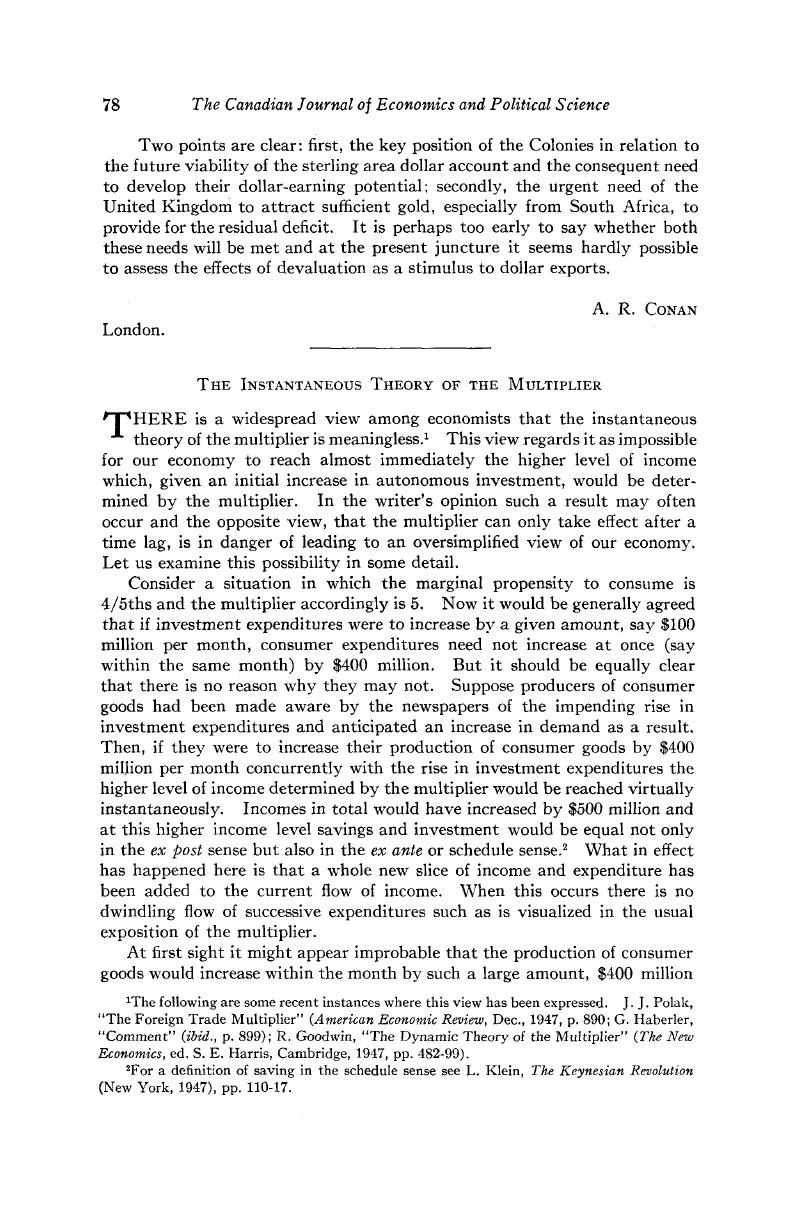Article contents
The Instantaneous Theory of the Multiplier
Published online by Cambridge University Press: 07 November 2014
Abstract

- Type
- Notes and Memoranda
- Information
- Canadian Journal of Economics and Political Science/Revue canadienne de economiques et science politique , Volume 16 , Issue 1 , February 1950 , pp. 78 - 82
- Copyright
- Copyright © Canadian Political Science Association 1950
References
1 The following are some recent instances where this view has been expressed. Polak, J. J., “The Foreign Trade Multiplier” (American Economic Review, 12, 1947, p. 890 Google Scholar; G. Haberler, “Comment” (ibid., p. 899); Goodwin, R., “The Dynamic Theory of the Multiplier” (The New Economics, ed. Harris, S. E., Cambridge, 1947, pp. 482–99).Google Scholar
2 For a definition of saving in the schedule sense see Klein, L., The Keynesian Revolution (New York, 1947), pp. 110–17.Google Scholar
3 Goodwin, , “The Dynamic Theory of the Multiplier,” p. 486.Google Scholar
4 The General Theory of Employment Interest and Money (New York, 1935), pp. 124–5.Google Scholar
5 Professor Haberler has described this as the “successive spending” or the commonsense approach. See Prosperity and Depression (3rd ed., Geneva, 1941), p 456.Google Scholar
6 In those instances where an attempt has been made to visualize the multiplier in terms of a time period of some definite length the time period has usually been defined in terms of how long it would take for an increase in spending to result in an increase in production and income. Estimates of between three and four months based on concepts of income velocity have been made by a number of writers. However these writers apparently fail to realize the incompatibility of a time period of this length with their assumption that no spending out of income occurs within the period in which it is earned. See Machlup, F., “Period Analysis and Multiplier Theory” (Readings in Business Cycle Theory, Philadelphia, 1944, p. 214. footnote 3Google Scholar) and the references made there to the works of Professors Villard and Angell.
7 A further qualification in respect to spending on services will be made below. In other respects the above conclusions seem to agree substantially with those reached by Professor Metzler. See, “Three Lags in the Circular Flow of Income” (Income, Employment and Public Policy—Essays in Honor of A. H. Hansen, New York, 1948, pp. 11–32).Google Scholar
8 This involuntary disinvestment in inventories is in addition to the “leakages” caused by the voluntary sale of goods out of inventory which have been frequently discussed in multiplier theory. For simplicity this example implicitly assumes that no retail markup exists. The problem raised by this will be treated below in connexion with spending on services.
9 A failure to allow for the disinvestment in inventories which occurs when the multiplicand is not reached instantaneously explains an error made by Mr. Thomas Wilson. The scarcity of savings which he believes must accompany a steady increase in investment expenditures corresponds exactly to the disinvestment in stocks which must on his assumptions occur. Thus funds released by this disinvestment would offset his scarcity. See Fluctuations in Income and Employment (3rd ed., New York, 1948), p. 79.Google Scholar
10 In 1938 expenditures on services amounted to about 38 per cent of total consumer expenditures on goods and services, in Canada. By 1948 this percentage had fallen to 27, this decline apparently being chiefly due to the effects of rent control. The markup on goods sold through independent retail stores amounted to about 24 per cent in 1941. See, Canada Dominion Bureau of Statistics, National Accounts: Income and Expenditure, 1941–1948 (Ottawa, 1949), p. 37 Google Scholar, and Eighth Census of Canada, 1941, vol. XI, Part I (Ottawa, 1944), p. 433.Google Scholar
- 1
- Cited by


